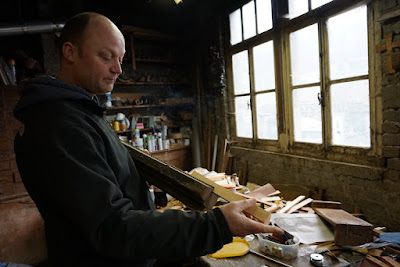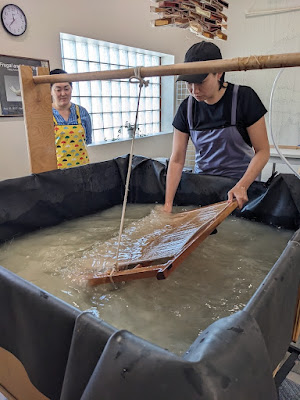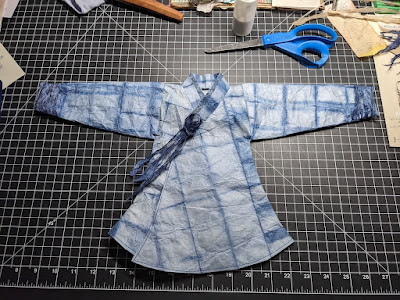I spent my time writing about Serge, and in between Pati and I harvested a bit of milkweed and processed it.
She also managed to orchestrate the most amazing birthday for me: friends, beautiful weather, glorious home-cooked meals, milkweed, writing, chocolate cake, and singing. I was so happy for one day to let go of whatever I thought my job was and simply be me while receiving love. On top of gifts, that was the ultimate gift.
Then I drove over to Kalamazoo to unload my car, which was completely stuffed with art, supplies, materials, and living needs for the next two weeks. I met Jeff at the book arts center, got groceries, and unloaded at the Airbnb (which is up a giant set of steps, and I decided immediately that I needed to only ever make one round trip a day because of how bad stairs are for my condition). Here is the gorgeous tree that I have been watching lose leaves in the backyard.
This is the giant paper studio full of all kinds of goodies, built by the late Paul Robbert (some of his equipment has been in Cleveland for years so I'm familiar with the kind of mind that would have come up with a lot of this rigging).
Spray with water to try and get the buoyant silks to calm down and not fly away.
Add some soda ash before cooking to further calm and then torture an intern by asking him to pull out extra seeds. I hadn't cooked these in YEARS and didn't remember the horrid scary ammonia smell. The staff got a big whiff and I did my best to rinse IMMEDIATELY so that I could tamp down the odor instead of letting it sit. Then I tortured another intern some more with loading the beater; I had forgotten how hellish it is to get it going since the structure of the cellulose in the coma makes it so hard. Tons of clogs but once it went, done so fast!
I also asked one intern to trim old, tough, defrosted, bleached (b/c of the stink) Thai kozo so that we could run it in the beater since I did not have energy to hand beat such tough stuff. Then I found a big deckle box and cleaned it as best as I could, and set it up in the sink. I LOVE BIG SINKS in a paper studio. I had access to one in grad school and did the same thing whenever I could: set up in the sink itself to drain more easily.
I had brought a lot of old fiber so that I could make paper to get a sense of how to best set up work flow in a space that I had only once taught in, but not done any production in. This was old mitsumata that was extremely stinky (I did a few rounds of bleach and vinegar) and then frozen, courtesy of an Oberlin student.
This was a good way also to test the small press, since I didn't trust the mechanized hydraulic at first for this kind of pressing. I'm used to feeling it by hand but of course overpressed anyhow (that's why the sheet is pulling off in the corner).
In between studio time and obsessing over places to eat/buy food, I've also had engagements at Western Michigan University. Jeff and I first went to hang the book portion of my show in their fancy archives/special collections building that is surrounded by rain gardens to hide the geothermal pumps that heat and cool this place.
Then I got a tour of the building, whereupon I saw the tallest archives and compact shelving I've ever seen. It's insane. Every employee here is trained on a big cherrypicker thing that looks like a tall forklift and has to wear a harness when they go up. Later last week I talked to a print class and did some teaching.
Back in the studio I had cooked some fresh Thai kozo and was very unhappy about the quality (terrible for lace), using it mostly to make new bark grids.
Just when it started to get disgusting (starting to smell like gross feet, which is NOT the smell I am used to for turning bark...the water here is very different!), I finally realized what I actually wanted to make.
For probably at least six years, I've been trying to make work about Korean door lattice patterns. I thought they were going to be small books but apparently I was supposed to make them out of bark! It's always wild when these old seeds finally sprout.
But that's the beauty of a residency, when your whole job is to be in the studio and stay present in your process so that you are prepared for these moments. I was so excited and took over the tables usually used for staff to work.
I did as many as I had bark for and yesterday cooked some old Thai kozo, batches from the same supplier, from over 20 years ago. It was wonderful to time travel, since this is the fiber I trained on in 2003, when we could soak overnight and then cook for 1.5 hours, 2 hours tops. Now we have extremely old, tough, thick fiber that we have to soak for days and then can cook ALL DAY (I've done 8 hours before) and it will never break down. Today I'll rinse the old/new batch and see how it laces/grids/beats.
There was a show about the Puerto Rican diaspora through collage and to get to it, you walk through a piece by Edra Soto.
What isn't obvious at first is that some of the circles are filled with mirrors that have holes, and you can look through each hole to view images from PR.
There were also two beautiful installations by Esmaa Mohamoud. I was glad to make this trip and have a bit of a weekend. The driving nearly did me in but I managed to start some embedding experiments with my leftover abaca before I turned in for the night. Now it feels like crunch time! Katie is sanding the gallery walls now that the last show is coming down and tomorrow we start to hang mine. I also give an artist talk tomorrow at WMU and then the show opens Friday. I leave after that to return for a full milkweed residency with Pati and Tim and two of my past hanji stduents. Wet work has to stop Thurs but it feels like I'm just getting started.


















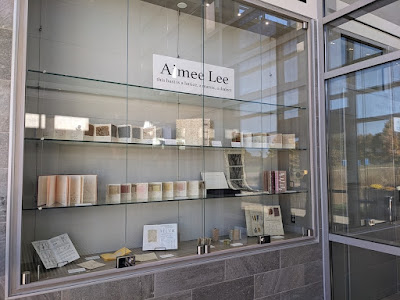



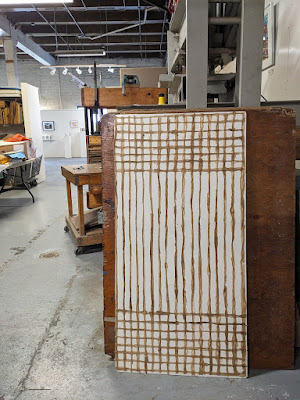



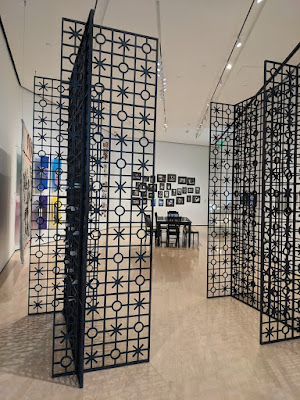


.jpeg)


.jpeg)

.jpeg)





